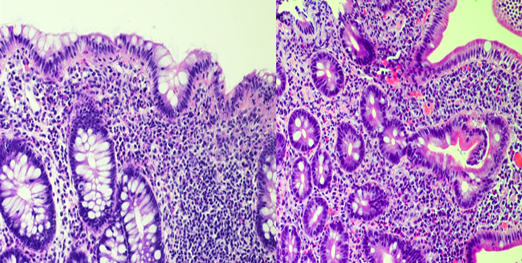Sunday Poster Session
Category: Colon
P0373 - Tirzepatide-Induced Eosinophilic Colitis: A Rare Gastrointestinal Presentation of a GLP-1 Receptor Agonist
Sunday, October 26, 2025
3:30 PM - 7:00 PM PDT
Location: Exhibit Hall
- KG
Keerthy Gopalakrishnan, MD
The Wright Center for Graduate Medical Education
Scranton, PA
Presenting Author(s)
Keerthy Gopalakrishnan, MD1, Danial Nadeem, MD2, Ghazal Ghafari, DO, MPH3, Nihaal Karnik, MD4
1The Wright Center for Graduate Medical Education, Scranton, PA; 2Geisinger Wyoming Valley Medical Center, Scranton, PA; 3Geisinger Health System, Danville, PA; 4Geisinger Wyoming Valley Medical Center, Wilkes-Barre, PA
Introduction: Tirzepatide, a dual agonist of the glucagon-like peptide-1 (GLP-1) and glucose-dependent insulinotropic polypeptide (GIP) receptors, has become widely used for managing type 2 diabetes and weight loss. While gastrointestinal (GI) side effects are well established, immune-mediated side effects are not well characterized. We report a novel case of eosinophilic colitis secondary to Tirzepatide use.
Case Description/
Methods: A 56-year-old male with a history of type 2 diabetes mellitus, hypertension, and gastroesophageal reflux disease (GERD) presented with one week of vomiting, diarrhea, and left lower quadrant abdominal pain. His symptoms began shortly after increasing his dose of tirzepatide. At presentation, the patient’s clinical findings were heart rate 98 bpm, White blood cell count 17.72 K/μL, Absolute eosinophils 1.14 K/μL, Sodium 132 mmol/L, Creatinine 2.1 mg/dL and Lactate 2.9 mmol/L. Abdominal imaging showed enteritis prompting empiric antibiotics, later discontinued after a negative GI pathogen panel. Given the patient’s persistent diarrhea and dehydration, the decision was made to perform bidirectional endoscopy as an inpatient. Bidirectional endoscopy was unremarkable. Given his diarrhea duodenal biopsies and random colonic biopsies were obtained. Colonic biopsy showed increased eosinophils and lymphoplasmacytic infiltrates [Fig 1]. Following de-escalation of tirzepatide, his symptoms gradually resolved. Repeat colonoscopy two months later showed no residual eosinophilic inflammation.
Discussion: To our knowledge, this is the first documented case of eosinophilic colitis associated with tirzepatide. Although GLP-1 receptor agonists have been implicated in eosinophilic fasciitis and other immune phenomena, the role of GLP-1 and GIP receptor modulation in eosinophil biology remains incompletely understood. Emerging studies suggest that GLP-1 analogs influence eosinophil activation and cytokine secretion, although effects may vary by disease state and individual susceptibility. As tirzepatide use expands particularly for weight loss, clinicians should maintain heightened awareness of potential immune-mediated complications. Prompt recognition and drug withdrawal are critical to improving patient outcomes. Further investigation is warranted to clarify the immunologic mechanisms underlying eosinophilic gastrointestinal toxicity associated with GLP-1/GIP receptor agonists.

Figure: Fig: 1 Eosinophilic infiltrate in the lamina propria of the colon.
Disclosures:
Keerthy Gopalakrishnan indicated no relevant financial relationships.
Danial Nadeem indicated no relevant financial relationships.
Ghazal Ghafari indicated no relevant financial relationships.
Nihaal Karnik indicated no relevant financial relationships.
Keerthy Gopalakrishnan, MD1, Danial Nadeem, MD2, Ghazal Ghafari, DO, MPH3, Nihaal Karnik, MD4. P0373 - Tirzepatide-Induced Eosinophilic Colitis: A Rare Gastrointestinal Presentation of a GLP-1 Receptor Agonist, ACG 2025 Annual Scientific Meeting Abstracts. Phoenix, AZ: American College of Gastroenterology.
1The Wright Center for Graduate Medical Education, Scranton, PA; 2Geisinger Wyoming Valley Medical Center, Scranton, PA; 3Geisinger Health System, Danville, PA; 4Geisinger Wyoming Valley Medical Center, Wilkes-Barre, PA
Introduction: Tirzepatide, a dual agonist of the glucagon-like peptide-1 (GLP-1) and glucose-dependent insulinotropic polypeptide (GIP) receptors, has become widely used for managing type 2 diabetes and weight loss. While gastrointestinal (GI) side effects are well established, immune-mediated side effects are not well characterized. We report a novel case of eosinophilic colitis secondary to Tirzepatide use.
Case Description/
Methods: A 56-year-old male with a history of type 2 diabetes mellitus, hypertension, and gastroesophageal reflux disease (GERD) presented with one week of vomiting, diarrhea, and left lower quadrant abdominal pain. His symptoms began shortly after increasing his dose of tirzepatide. At presentation, the patient’s clinical findings were heart rate 98 bpm, White blood cell count 17.72 K/μL, Absolute eosinophils 1.14 K/μL, Sodium 132 mmol/L, Creatinine 2.1 mg/dL and Lactate 2.9 mmol/L. Abdominal imaging showed enteritis prompting empiric antibiotics, later discontinued after a negative GI pathogen panel. Given the patient’s persistent diarrhea and dehydration, the decision was made to perform bidirectional endoscopy as an inpatient. Bidirectional endoscopy was unremarkable. Given his diarrhea duodenal biopsies and random colonic biopsies were obtained. Colonic biopsy showed increased eosinophils and lymphoplasmacytic infiltrates [Fig 1]. Following de-escalation of tirzepatide, his symptoms gradually resolved. Repeat colonoscopy two months later showed no residual eosinophilic inflammation.
Discussion: To our knowledge, this is the first documented case of eosinophilic colitis associated with tirzepatide. Although GLP-1 receptor agonists have been implicated in eosinophilic fasciitis and other immune phenomena, the role of GLP-1 and GIP receptor modulation in eosinophil biology remains incompletely understood. Emerging studies suggest that GLP-1 analogs influence eosinophil activation and cytokine secretion, although effects may vary by disease state and individual susceptibility. As tirzepatide use expands particularly for weight loss, clinicians should maintain heightened awareness of potential immune-mediated complications. Prompt recognition and drug withdrawal are critical to improving patient outcomes. Further investigation is warranted to clarify the immunologic mechanisms underlying eosinophilic gastrointestinal toxicity associated with GLP-1/GIP receptor agonists.

Figure: Fig: 1 Eosinophilic infiltrate in the lamina propria of the colon.
Disclosures:
Keerthy Gopalakrishnan indicated no relevant financial relationships.
Danial Nadeem indicated no relevant financial relationships.
Ghazal Ghafari indicated no relevant financial relationships.
Nihaal Karnik indicated no relevant financial relationships.
Keerthy Gopalakrishnan, MD1, Danial Nadeem, MD2, Ghazal Ghafari, DO, MPH3, Nihaal Karnik, MD4. P0373 - Tirzepatide-Induced Eosinophilic Colitis: A Rare Gastrointestinal Presentation of a GLP-1 Receptor Agonist, ACG 2025 Annual Scientific Meeting Abstracts. Phoenix, AZ: American College of Gastroenterology.
